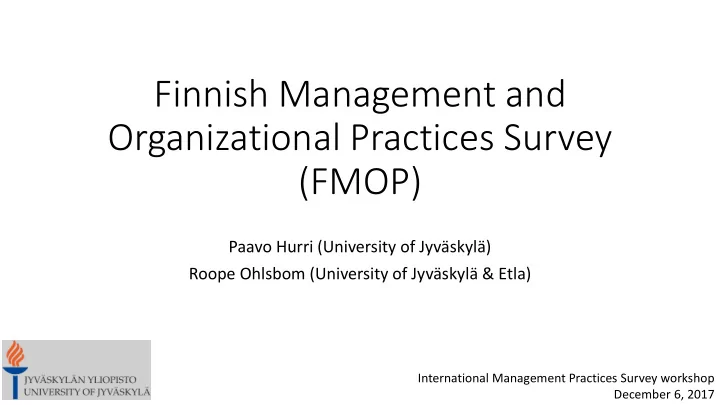

Finnish Management and Organizational Practices Survey (FMOP) Paavo Hurri (University of Jyväskylä) Roope Ohlsbom (University of Jyväskylä & Etla) International Management Practices Survey workshop December 6, 2017
Contents • Background • Data Collection Process • The FMOP Data • Some Descriptive Statistics
Background • First (quantitative) management survey in Finland • World Management Survey covering vocational schools • Questionnaire replicated closely from the 2010 US MOPS • Part of the Skills, Education and the Future of Work research project • Funded by the Strategic Research Council at the Academy of Finland • A governmental funding body for scientific research in Finland. • So far one publication based on FMOP in ETLA Reports (only in Finnish) • Executive summary in English has been provided with these slides
Data Collection Process • Phone calls • Acquire contact information of establishment managers • Trained interviewers • Second phase: Electronic survey by email • Introduction of FMOP and a link to the web questionnaire • 3 follow-up emails to non-responding establishments • No information about most non-respondents • Feedback: • Many firms only respond if required by law • Difficulties in answering on establishment level (instead of firm level) • Technical difficulties
The FMOP Sample • Sample is based on the financial statements inquiry for enterprises (TILKES) by Statistics Finland • Covers 6000 enterprises • http://www.tilastokeskus.fi/keruu/yrti/index_en.html • Sample consisted of 2509 manufacturing establishments • At least 4 employees and satisfies one of the following conditions: • Belongs to an enterprise with more than 50 employees • Belongs to an enterprise with a turnover of over EUR 40 million • Belongs to an enterprise with a balance sheet of more than EUR 300 million
The FMOP Data • Final number of valid respondents 731 • Rate of response (gross) approximately 31% • Analysis of total non-response: distribution skewed towards larger establishments • Two different post-stratification weights calculated to correct for non- response bias • Item non-response: 95% of valid respondents gave at least 11 non- missing responses
Descriptive Statistics • Dispersion of unweighted average management score in Finnish manufacturing establishments • n = 697
Descriptive Statistics • Post-stratification weighted average management score by establishment size (measured as number of employees) with confidence intervals
Descriptive Statistics • Post-stratification weighted average management score by Finnish large areas (NUTS 2) • No significant cross-regional differences • Same mostly applies to Finnish regions
Descriptive Statistics • Post-stratification weighted average management score divided into three sections: Monitoring, incentives and targets • Incentives comparatively weaker than performance monitoring and targets
Thank You!
Recommend
More recommend